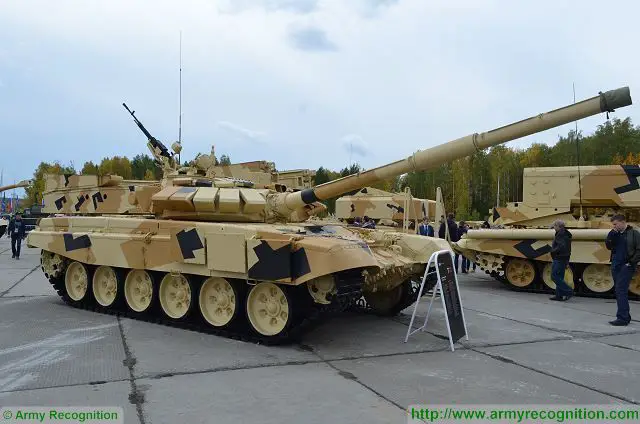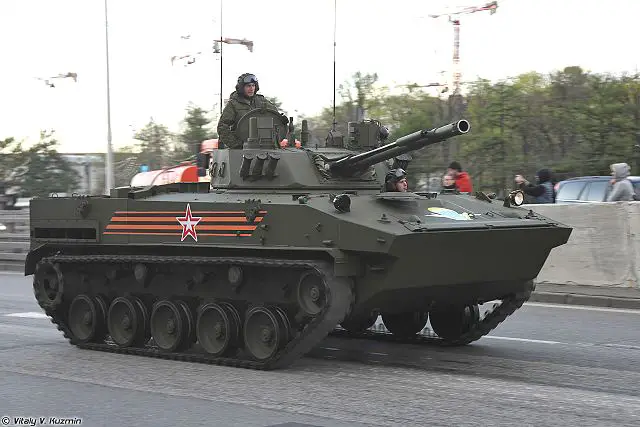|
|
|||
|
Defence & Security News - Russia
|
|||
|
|
|||
| Upgraded T-72B3 MBT wil be the backbone of tank companies of Russian Airborne Forces. | |||
|
Upgraded T-72B3 main battle tanks (MBT) will be the backbone of the tank companies being formed by the Russian Airborne Force, according to the Gazeta.ru news portal. The tank companies will receive upgraded T-72B3s. According to Uralvagonzavod Director General Oleg Siyenko, about 200 T-72B3s will have been delivered in 2016 alone. The upgraded tanks are fitted out with more powerful engines and add-on turret, bottom and side armor protection.
|
|||
|
|
|||
 Russian- T-72B3 main battle tank at RAE 2015, defense exhibition in Nizhny Tagil, Russia. Russian- T-72B3 main battle tank at RAE 2015, defense exhibition in Nizhny Tagil, Russia. |
|||
|
|
|||
|
The air assault brigades of the Russian Airborne Force will have tank companies from December 1, the branch’s commander, Colonel General Vladimir Shamanov, told journalists. Airborne includes three types of units - parachute, air assault and air assault (mountain). According to its commander, the tanks will be received after August. All noncommissioned officer billets in the branch will have been manned by enlistees, rather than draftees, by December 1. The objective is to achieve an enlisteds-to-draftees ratio of 80:20. Only one air assault brigade has become all-volunteer to date. The brigade stationed in Ulyanovsk is assigned to the Collective Security Treaty Organization’s (CSTO) Collective Rapid Reaction Force (CRRF) and the United Nations peacekeeping forces.
Expert Victor Murakhovsky said the lessons learnt, inter alia, by Airborne’s air assault units showed that the latter had to be augmented with tanks. This was done in Afghanistan and in other armed conflicts, including those in the former Soviet states, in the North Caucasus. The tank is the key element of combined-arms battle. Previously, when needed, tanks would be borrowed from the Army, because the table of organization and equipment (TO&E) of the Airborne Force lacked them, but now they will be organic to the air assault units. This time around, tank companies are to be formed by air assault brigades, but they are expected to grow into battalions further down the road. The measure is the optimization of the TO&E. Hence, they are placed on it, and the rest of Airborne will have an opportunity to learn to fight in conjunction with them. |
|||
|
|
|||
 Russian army BMD-4M airborne infantry fighting vehicle at military parade in Moscow, Russia. Russian army BMD-4M airborne infantry fighting vehicle at military parade in Moscow, Russia. |
|||
|
|
|||
|
Each of the air assault brigades will get a tank company. The tanks shall not conduct parachute landing, because they are supposed to be air-landed. Air assault brigades are mostly used on the ground, they have never jumped into combat zones, let alone doing so along with their vehicles. Parachute units will be auxiliary to them. Essentially, they are highly mobile ground forces.
At present, numerous combat vehicles are in development for Airborne, e.g. the BMD-4M airborne infantry fighting vehicle and BTR-MDM Rakushka armored personnel carrier have entered service recently. The Paras intend to take delivery of about 140 BMD-4Ms and around 90 BTR-MDMs in 2016 alone. More than 1,500 BMD-4Ms and in excess of 2,500 Rakushkas are due to Airborne’s inventory by 2025. Troops are testing the advanced RKhM-5 CBRN reconnaissance vehicle. Quadbikes and snowmobiles are being fielded. The Taifun four-wheeled vehicle is in development for Airborne’s scout and commando units and for the Special Operations Forces. Col. Gen. Shamanov intends to have 80-85% of his command’s inventory made up of the latest combat gear, with plans providing for advanced materiel to account for 70% of the Russian Armed Forces’ inventory by 2020. According to Murakhovsky, the weapons mix of Airborne is not optimal now, given the realities and the branch’s missions. He noted that the missions the paratroopers had accomplish in the Soviet times, e.g. airborne operations when a whole of airborne division would jump in one go at long distance to attain operational-strategic objectives, were not relevant any longer. Today, neither the Military Transport Aviation can lift that many paratroops, nor such objectives exist. Some of the Paras have taken part in the operation in Syria, but not in the immediate fighting. Rather, they have been fighting as special operators. The post-WWII experience has showed that even when Airborne deployed, e.g. in Czechoslovakia in 1968, the troops never jumped along with their fighting vehicles. The vehicles the Paras need are far more expensive than ordinary ones, because they have to be outfitted with special airdrop equipment. This makes the branch’s upkeep very expensive. Hence, the money is invested into something that has never been used and is hardly to be used. When airborne operations were practiced in the Soviet times, horrendous resources would be needed in support of airdropping a single airborne division, including several tactical and bomber air divisions, fighters to provide air coverage, rocket, missile and tube artillery units to clobber the enemy along the route followed by the airlifters, etc. In such a situation, the activation of tank companies is a step in the right direction, it is optimization. According to Vladimir Shamanov, there will be six tank companies in the Airborne Force. In addition, two companies of unmanned aerial vehicles, including attack ones, and two electronic warfare companies are to be formed by Airborne in 2016, according to the Gazeta.ru online news agency. |
|||
|
|
|||
|
© Copyright 2016 TASS. All rights reserved. This material may not be published, broadcast, rewritten or redistributed.
|
|||
Upgraded T-72B3 MBT wil be the backbone of tank companies of Russian Airborne Forces TASS 10707166
- Posted On














